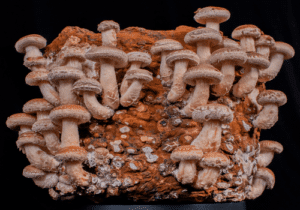
SHIITAKE: Grow Kit Instructions
Learn how to grow Shiitake mushrooms using the Myterra Labs
RECEIVE 10% OFF ON YOUR FIRST ORDER! – USE CODE: WELCOME10

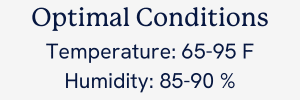

A full list of the contents is included in your grow kit, but let’s go over each item to make sure that you have everything you need to get growing.
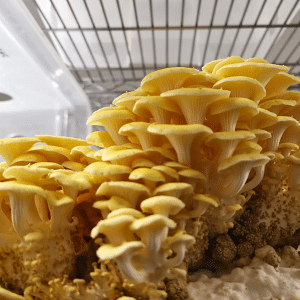
Are you ready to start growing your own beautiful bouquet of Golden Oyster mushrooms? Then let’s get started!
Inoculation means to add a culture into a growing medium – in this case, you will be adding your liquid culture into the rye grains in the lower portion of your kit where the X is marked on the picture below.
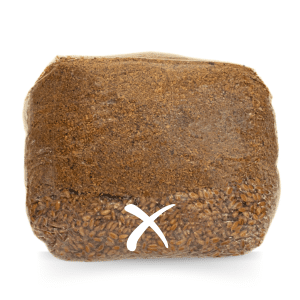
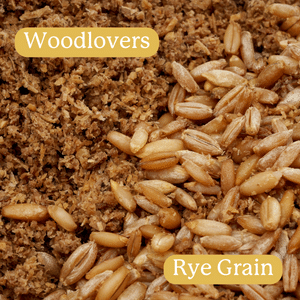
Not too sure how to complete this process? Watch the video below to see how we do it.
Patience is the hardest part of growing mushrooms. The excitement and anticipation will grow as you watch the white threads of mycelium growing through you kit.
For this stage of growth, you are aiming to get the mushroom mycelium growing through all the grains – don’t worry, the mushrooms will know which way to go to find the grains. Grains are packed full of nutrition and are the perfect food to start growing mushrooms on. Think of the grains as baby food and the hardwood substrate as adult food. Mushrooms will need as much nutrition as possible while they are establishing themselves before moving onto a different food source: wood. Below you can see the white mycelium starting to grow on the grains.
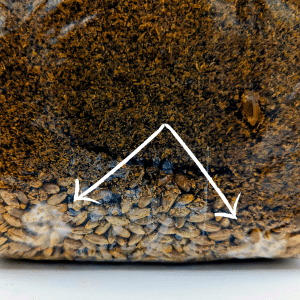
Keep the bag upright and follow these tips to get the best growth from your mushrooms:
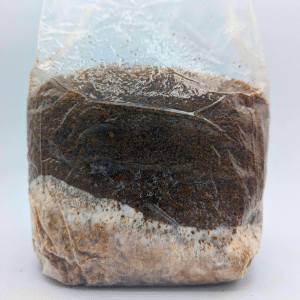

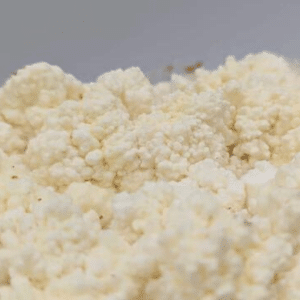
Fruiting is the phase of growth in which visible mushrooms begin to appear on your kit. Mushroom mycelium is triggered into the fruiting stage by two factors: full colonization of the growing medium (kit) and an increase in fresh air. This is why your kit needs to be fully colonized before starting the fruiting process.
When growing mushrooms, you can direct where you want the mushrooms (or fruits) to form and here’s how:

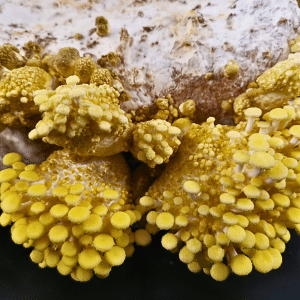
As the pins grow, you will be able to differentiate between the cap/pileus of the mushroom and the stem/stipe of the mushroom. If the stems look very long and the caps don’t grow at the same speed or faster than the stem, your mushrooms need more fresh air. Cut slits into the humidity bag to allow small amounts of fresh air into the humidity bag.
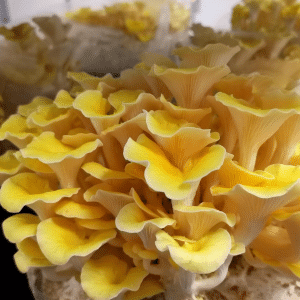
Knowing when to harvest your mushrooms is a quick skill to learn. It is very tempting to let your mushrooms grow for longer than they should. We are big advocates for experimentation so if this is your first time growing and you simply want to see how big they can grow then by all means have some fun and try it out. Keep in mind that if golden oysters are harvested past their prime, they will produce a prolific amount of spores. People who are sensitive to spores or have respiratory conditions are at risk of irritation to their respiratory pathways while the mushroom is producing spores.
If you want to harvest your mushrooms at their prime for cooking then follow the steps below.
When the edges of your mushrooms look like the images below, you are ready to harvest. Gently grab the base of the mushroom and twist the mushroom while pulling it away from the kit. Golden oysters can have very thick stem bases, connecting to the substrate. If the stem is very firm, you can use a knife to cut through the base of the mushroom cluster, close to the substrate.
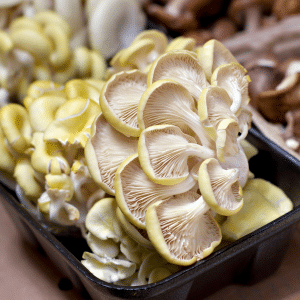
Once you’ve harvested your mushrooms, you’ll be able to get a second harvest or “flush” of mushrooms. Mushrooms can continue to grow as long as they have all of the requirements for growth such as: water and nutrition. The Myterra Labs Easy Mushroom Grow Kit has more than enough of both to sustain your mushrooms for a second round of mushrooms to form. Here’s what you need to do:
It’s as simple as that. Wait for 1-2 weeks to see fully mature mushrooms before harvesting.
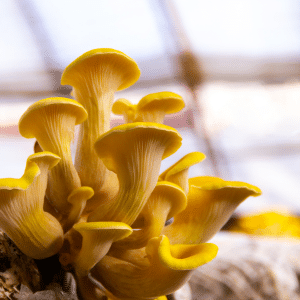
Well done! You’ve successfully grown your own mushrooms. The options for what to do next are endless.
If you would like to increase the amount of vitamin D in your mushrooms, leave the harvested mushrooms in the sun for 15-30 minutes. That’s all it takes!
Cooking: There are numerous ways to cook golden oyster mushrooms with an abundant number of recipes online. We recommend cooking these mushrooms on a high heat pan without oil. When the mushrooms start to turn brown or stick to the bottom of the pan, add in your oils/butter and garlic. These mushrooms can compliment any spicy dish, but are also great with your favorite meal.
Long term storage: If you grow multiple kits at once or if you’re going away for a week, you can dry your harvested mushrooms by slicing the mushrooms into strips. Mushrooms can be dried whole, but they take longer to dry. Airdry at 115F for 24-28 hours or until they are dry enough to snap apart. Store in an air-tight container for up to 6 months.
You are officially part of the mushroom growing community! Share your success on social media and follow us for more mushroom growing tips and tricks – there are so many mushrooms that you can test your new growing skills on!
If you liked growing golden oyster mushrooms and want to expand your mushroom growing skills, we suggest growing White Oyster mushrooms.
White oyster mushrooms are pearlescent and elegant with soft flesh. Although the golden and white oysters are both oyster mushrooms, their flavors and textures are very different. Our white oyster strain produces large clusters of mushrooms, providing a larger harvest than the golden oyster. The white oyster mushroom is easier to grow than the golden oysters because white oysters can tolerate a larger range of environmental conditions.
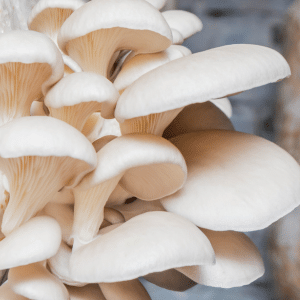



A full list of the contents is included in your grow kit, but let’s go over each item to make sure that you have everything you need to get growing.

Are you ready to start growing your own beautiful bouquet of Golden Oyster mushrooms? Then let’s get started!
Inoculation means to add a culture into a growing medium – in this case, you will be adding your liquid culture into the rye grains in the lower portion of your kit where the X is marked on the picture below.


Not too sure how to complete this process? Watch the video below to see how we do it.
Patience is the hardest part of growing mushrooms. The excitement and anticipation will grow as you watch the white threads of mycelium growing through you kit.
For this stage of growth, you are aiming to get the mushroom mycelium growing through all the grains – don’t worry, the mushrooms will know which way to go to find the grains. Grains are packed full of nutrition and are the perfect food to start growing mushrooms on. Think of the grains as baby food and the hardwood substrate as adult food. Mushrooms will need as much nutrition as possible while they are establishing themselves before moving onto a different food source: wood. Below you can see the white mycelium starting to grow on the grains.

Keep the bag upright and follow these tips to get the best growth from your mushrooms:



Fruiting is the phase of growth in which visible mushrooms begin to appear on your kit. Mushroom mycelium is triggered into the fruiting stage by two factors: full colonization of the growing medium (kit) and an increase in fresh air. This is why your kit needs to be fully colonized before starting the fruiting process.
When growing mushrooms, you can direct where you want the mushrooms (or fruits) to form and here’s how:


As the pins grow, you will be able to differentiate between the cap/pileus of the mushroom and the stem/stipe of the mushroom. If the stems look very long and the caps don’t grow at the same speed or faster than the stem, your mushrooms need more fresh air. Cut slits into the humidity bag to allow small amounts of fresh air into the humidity bag.

Knowing when to harvest your mushrooms is a quick skill to learn. It is very tempting to let your mushrooms grow for longer than they should. We are big advocates for experimentation so if this is your first time growing and you simply want to see how big they can grow then by all means have some fun and try it out. Keep in mind that if golden oysters are harvested past their prime, they will produce a prolific amount of spores. People who are sensitive to spores or have respiratory conditions are at risk of irritation to their respiratory pathways while the mushroom is producing spores.
If you want to harvest your mushrooms at their prime for cooking then follow the steps below.
When the edges of your mushrooms look like the images below, you are ready to harvest. Gently grab the base of the mushroom and twist the mushroom while pulling it away from the kit. Golden oysters can have very thick stem bases, connecting to the substrate. If the stem is very firm, you can use a knife to cut through the base of the mushroom cluster, close to the substrate.

Once you’ve harvested your mushrooms, you’ll be able to get a second harvest or “flush” of mushrooms. Mushrooms can continue to grow as long as they have all of the requirements for growth such as: water and nutrition. The Myterra Labs Easy Mushroom Grow Kit has more than enough of both to sustain your mushrooms for a second round of mushrooms to form. Here’s what you need to do:
It’s as simple as that. Wait for 1-2 weeks to see fully mature mushrooms before harvesting.

Well done! You’ve successfully grown your own mushrooms. The options for what to do next are endless.
If you would like to increase the amount of vitamin D in your mushrooms, leave the harvested mushrooms in the sun for 15-30 minutes. That’s all it takes!
Cooking: There are numerous ways to cook golden oyster mushrooms with an abundant number of recipes online. We recommend cooking these mushrooms on a high heat pan without oil. When the mushrooms start to turn brown or stick to the bottom of the pan, add in your oils/butter and garlic. These mushrooms can compliment any spicy dish, but are also great with your favorite meal.
Long term storage: If you grow multiple kits at once or if you’re going away for a week, you can dry your harvested mushrooms by slicing the mushrooms into strips. Mushrooms can be dried whole, but they take longer to dry. Airdry at 115F for 24-28 hours or until they are dry enough to snap apart. Store in an air-tight container for up to 6 months.
You are officially part of the mushroom growing community! Share your success on social media and follow us for more mushroom growing tips and tricks – there are so many mushrooms that you can test your new growing skills on!
If you liked growing golden oyster mushrooms and want to expand your mushroom growing skills, we suggest growing White Oyster mushrooms.
White oyster mushrooms are pearlescent and elegant with soft flesh. Although the golden and white oysters are both oyster mushrooms, their flavors and textures are very different. Our white oyster strain produces large clusters of mushrooms, providing a larger harvest than the golden oyster. The white oyster mushroom is easier to grow than the golden oysters because white oysters can tolerate a larger range of environmental conditions.


Learn how to grow Shiitake mushrooms using the Myterra Labs
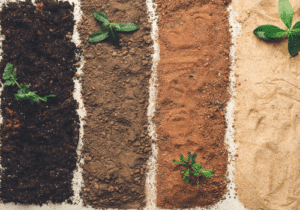
Selecting the right substrate is a key element in successful
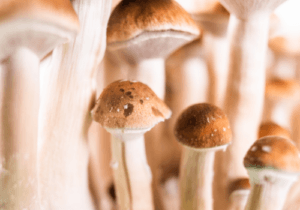
Welcome to the enchanting realm of our All-in-one Grow Kit,
© 2023 Myterra Labs. Designed by Laura Ramsay. Developed by Info2grow Media Services.